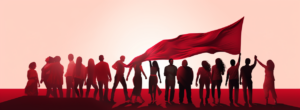Building workforce resilience in the age of the coronavirus and beyond
- 4 Min Read
How can people leaders use the widespread disruption of COVID-19 to help strengthen their workforces and prepare them for the next challenge?
- Author: Evian Gordon, MD, PhD
- Date published: Apr 2, 2020
- Categories

Business as usual is no more. Organizations worldwide are reeling from the impacts of COVID-19 (Coronavirus). There is not one facet of business that is not touched by this, uncomfortable at best, deadly at worst, contagion.
This global pandemic is forcing workers into isolation, destroying corporate culture and for some companies, threatening solvency. Corporate stocks are spiraling downward, and employee anxiety is spiraling upward.
Anxiety is high, productivity is down.
According to a recent study commissioned by Total Brain, a mental health and wellness platform, more than half (58%) of U.S. employees report feeling anxiety related to COVID-19. Of those, 20% say they are very anxious. These stark numbers are noteworthy as the survey was taken at the early phase of the pandemic and anxiety amplifies very quickly across organizations, much like the virus itself. People are innately programmed to feel fear when others around them are scared – even in circumstances where it becomes an unhelpfully high level of panic.
Uncertainty is one of the most fearful situations. Uncertainty is threatening because it means things can’t be predicted or controlled. This triggers the brain’s fear networks and a loss of ability to respond rationally. When we are unable to respond rationally, we tend to focus on the problem rather than the solution.
What does this mean for business leaders? Almost two in five (35%) Americans report that anxiety is interfering with their workplace productivity, and one in four states that it is negatively impacting the quality of their work. Research has found that feeling fearful strongly predisposes people toward increasing levels of distress and growing negativity. The result: difficulty focusing, processing information and making flexible solution focused clear decisions. None of these behaviors are good for people and certainly not for business – no matter the industry.
Strengthening employees “bounce-back” reflex
Our research has shown that nearly two in five workers are looking to their employers for resources to help quell anxiety. So how can organizations keep people focused through fast-changing and unprecedented adversity? How can they help workers strengthen their “bounce-back” reflex?
Here are four simple ways business leaders can help reduce employees’ vulnerability to stress and strengthen their resilience:
- Provide clear guidance: give employees resources to deal with radical new workplace challenges such as tips, guidelines, operating procedures and names and contacts of those who can provide support in difficult situations, such as childcare issues, remote work IT problems, financial concerns.
- Be Transparent: Be open about bad news and potential problems. Don’t leave your employees wondering what’s happening. Being in the dark unable to predict what will happen stokes fear. Even if you don’t have all the answers, keep the lines of communication open with your workers, with a solution focused context.
- Offer Self-care Resources: Resilience is not a trait we have or that we don’t have. It is not innate. Anyone can learn to be resilient. Explore online platforms that offer people the ability to monitor anxiety levels and overall mental health. Offer programs that provide self-care support and resilience training exercises that address the total brain. Resilience is a learned ability that requires insight into the brain’s key capacities, awareness of mental health, tools and objective tracking of what works to reduce anxiety and recover from overcoming major challenges.
- Foster a Culture of Compassion: A new field of research is suggesting that when organizations promote an ethic of compassion rather than a culture of stress, they may not only see a happier workplace but also an improved bottom line. During this time of social isolation, leaders must demonstrate fairness and self-sacrificing and use compassion as a way to connect with their employees in a meaningful and new way.
Employers and employees cannot control the COVID-19 situation. However, all can learn to be more flexible and adaptive to better control their response. If you don’t already have a plan to support employee mental health and wellness, it’s not too late. Organizations that prioritize mental health will reap the benefits of happy people and productive employees. This stands true now during a pandemic but will remain true well after the world gets back to normal. Having a platform or strategy to help employees deal with challenges in a strategic manner is a win-win for everyone.
Evian Gordon, MD, PhD is co-founder and Chief Medical Officer of Total Brain, a Mental Health, Wellness and Support Platform. Dr. Gordon has more than 30 years of experience in applied human brain research and is considered one of the originators of the field of integrative neuroscience. He set up the first standardized and integrative international database of key aspects about the brain. He has over 250 peer reviewed publications. He is also the author of The Brain Revolution: Know and Train New Brain Habits.








